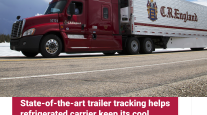DTNA Unveils In-Cab Tablet, Communications Package
This story appears in the Sept. 23 print edition of Transport Topics.
DETROIT — Daimler Trucks North America announced a pair of significant expansions in its telematics offerings here, unveiling the first factory-installed computer tablet for its trucks and a new communications package to seamlessly provide services over that tablet.
At a press briefing in the headquarters of its Detroit brand subsidiary Sept. 18, DTNA officials said the tablet, which it has developed in conjunction with Zonar Systems Inc., will be offered for sale in January, after several more months of testing.
David Hames, DTNA’s general manager of marketing and strategy, said the new offerings were part of the company’s drive to “leverage proprietary data to improve the bottom line” of its fleet customers.
Beginning in January, customers will be able to begin ordering Freightliner Cascadia tractors with the pre-wiring for the tablet in place.
Later in 2014, the tablet will be available in other Freightliner models through retrofit kits. Officials said the device also will be offered eventually in its Western Star models.
The tablet will nest into a docking station on the dashboard and provide access to DTNA’s existing “Virtual Technician” diagnostics system, as well as its Visibility fleet software, the suite of telematics programs the company unveiled here.
Visibility initially will include 17 programs, including hours-of-service logs, navigation, text-to-voice communications and a pre- and post-trip inspection tool for drivers.
DTNA also announced a new branding for all of its telematics offerings, including the tablet, under the name Detroit Connect.
Detroit produces engines, transmissions and axles for DTNA and is the home for its Virtual Technician program.
The new tablet “is an intuitive tool that will help our customers and their drivers maximize operations while ensuring compliance with the new” HOS regulation created by the Federal Motor Carrier Safety Administration to oversee driver work rules.
The tablet incorporates an electronic log that has been accepted as compliant by the U.S. Department of Transportation, the company said.
Through the Visibility package, drivers will be able to retrieve texts that are sent from their fleets; the tablet will convert the texts to voice messages that the driver can hear while the vehicle is in motion.
The tablet, which will run on the Android operating system, eventually will be available to third-party software providers through an online applications store, officials said.
The small tablet also includes a color screen, a flashlight, a camera and Bluetooth capability.
The device is part of an exclusive agreement between Zonar, which makes other mobile communications devices, and DTNA. Software for the tablet will come from Zonar, DTNA and ALK Technologies.
Fleets will pay to have the tablet pre-wiring installed in their vehicles and then will pay a monthly fee for the tablet and related services.
Hames said there were currently 60,000 vehicles on the road utilizing its Virtual Technician product, which automatically connects the vehicles with technicians at DTNA’s Detroit subsidiary when problems develop with their vehicles.
The technicians diagnose the problems based on information the truck provides, and a solution is devised in cooperation with the fleet customer, based on the severity of the issue.
The Visibility package also will include an automated pre- and post-trip inspection regime for drivers, who will be prompted through a series of checklists to inspect the truck’s equipment. The system will allow drivers to take pictures of problems they find and e-mail them to company technicians to assist in repairs.
Also last week, DTNA announced it will begin offering its automated manual transmission, the DT12, with 13-liter Detroit engines in its Cascadia models.
Up to now, the DT12 has been available only in Cascadias equipped with 15-liter engines.
Brad Williamson, manager of engine and component marketing for DTNA, said the new pairing is aimed at regional haulers and pickup-and-delivery fleets.
“Because the types of routes that they run, which involve a lot of stop-and-go operations, our regional-haul customers are seeking ways to extend fuel economy,” Williamson said. One of the company’s answers, he said, is to combine the AMTs with the smaller heavy-duty engine.
The company will accept orders for the new combination, effective immediately.




